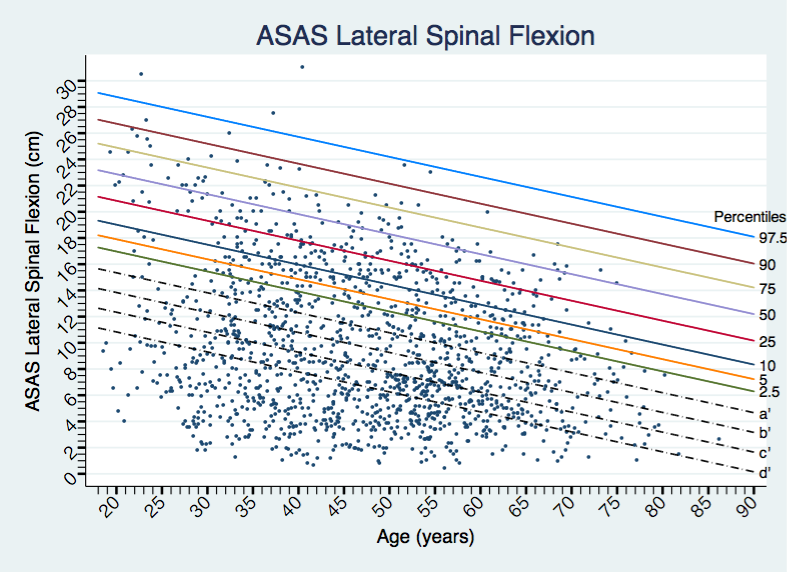Session Information
Session Type: Abstract Submissions (ACR)
Background/Purpose: Spinal mobility is impaired in patients with ankylosing spondylitis (AS) compared to normal subjects. However, the extent of impairment and the relative contribution of different measures are unknown. We investigated which spinal mobility measures are most frequently impaired in patients with AS and whether a hierarchy for the impairment of the measures could be established.
Methods: Patients from the Outcome in AS International Study (OASIS) were followed-up for up to 12 years in which spinal mobility was regularly measured (measures detailed in Table). From a previous study in normal subjects (1), percentile curves (2.5th to 97.5th) were obtained for each of the spinal mobility measures (Figure). We added 4 parallel curves representing z-scores of 2.5, 3, 3.5 and 4 respectively (helplines a to d) to be able to plot impaired measures. For every observation, and taking patient’s age into account, each of the spinal mobility measures was defined as impaired if the measurement fell below each of the cutoffs (2.5th percentile and each of the 4 helplines). The proportion of observations and also of patients (using baseline observation) in which each of the spinal mobility measures was impaired according to each of the cutoffs was calculated. Analyses were repeated in strata according to gender, symptom duration (median and tertiles) and baseline number of syndemophytes (0 vs ³1 and <5 vs³5).
Results: A total of 216 patients were included (70% males, mean (SD) age 44(13) years, mean symptom duration 21(12) years and 85% HLA-B27 positive). Lateral spinal flexion (LSF) was always the most frequently impaired measure, sequentially followed by Schober’s, tragus-to-wall, cervical rotation, intermalleolar distance (IMD) and chest expansion (CE) (Table). This order was strikingly similar at both the observation-level and the patient-level (baseline observations only) as well as for all cutoffs (with the only exception being the 2.5th percentile, for which CE was slightly more impaired than IMD). Even with stratifications did this hierarchy in general persist.
Conclusion: LSF and Schober’s are the most frequently impaired mobility measures in AS, reflecting an earlier involvement of lumbar spine in spinal mobility impairment, followed by the involvement of the thoracic and cervical spine. This fixed order of involvement of the spine persists across different patient groups.
References: (1) Ramiro et al. Arthritis & Rheumatism 64(12):4173-4174
Figure – Lateral spinal flexion in function of age and with the percentile curves and help-lines derived from the normal subjects measurements
|
Table – Impairment of each of the spinal mobility measures in patients with AS compared to cutoffs derived from mobility in normal subjects |
||||||
|
|
Below 2.5th percentile n (%)
|
Below Helpline a n (%)
|
Below Helpline b n (%)
|
Below Helpline c n (%)
|
Below Helpline d n (%)
|
Total number of observations (N)
|
|
OBSERVATION LEVEL (ALL OBSERVATIONS)
|
||||||
|
ASAS Lateral Spinal Flexion (cm)
|
1052 (73)
|
933 (64)
|
818 (57)
|
673 (47)
|
321 (22)
|
1447
|
|
10-cm Schober’s test (cm)
|
906 (58)
|
745 (48)
|
609 (39)
|
480 (31)
|
294 (19)
|
1551
|
|
Tragus-to-wall distance (cm)
|
679 (44)
|
532 (34)
|
363 (23)
|
*
|
*
|
1550
|
|
Cervical rotation (degrees)
|
486 (31)
|
382 (25)
|
300 (19)
|
236 (15)
|
187 (12)
|
1555
|
|
Intermalleolar distance (cm)
|
343 (22)
|
220 (14)
|
161 (10)
|
97 (6)
|
62 (4)
|
1543
|
|
Chest expansion (cm)
|
412 (27)
|
151 (10)
|
37 (2)
|
5 (0)
|
1 (0)
|
1548
|
|
*Not possible to derive these values due to mathematical characteristics of the equation for the percentile curves for tragus-to-wall distance
|
||||||
Disclosure:
S. Ramiro,
None;
R. Landewé,
None;
D. van der Heijde,
None;
C. Stolwijk,
None;
M. Dougados,
None;
F. Van den Bosch,
None;
A. M. van Tubergen,
None.
« Back to 2013 ACR/ARHP Annual Meeting
ACR Meeting Abstracts - https://acrabstracts.org/abstract/spinal-mobility-gets-impaired-in-a-fixed-order-in-patients-with-ankylosing-spondylitis-12-year-oasis-results/

